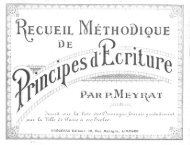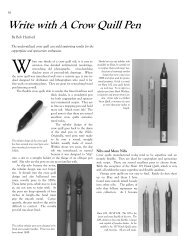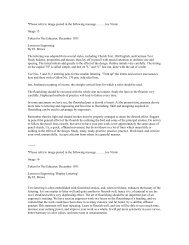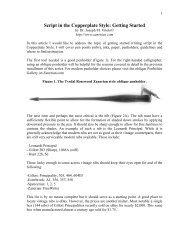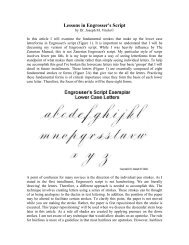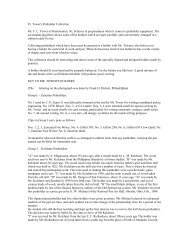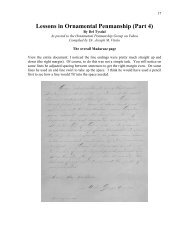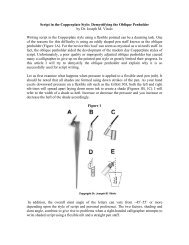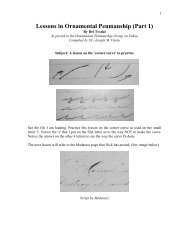The Educator (Volume 45) - IAMPETH
The Educator (Volume 45) - IAMPETH
The Educator (Volume 45) - IAMPETH
Create successful ePaper yourself
Turn your PDF publications into a flip-book with our unique Google optimized e-Paper software.
16 <strong>The</strong> <strong>Educator</strong><br />
paper). It groes very straight across<br />
the page . . . <strong>The</strong> first thing we learn<br />
in this class is good citizenship. We<br />
have been stressing it all term and so<br />
we shall choose the sentence we are<br />
to write on this subject. If we are<br />
obedient, kind, and honest, we are<br />
good citizens. Who can think of a<br />
good sentence for us to write?<br />
.\nna: I will be polite.<br />
John: I will be kind in all my<br />
thoughts.<br />
Caroline: Citizens are truthful.<br />
Helen: I will not gossip. (Audience<br />
laughs approvingly.)<br />
Shirley: Good citizens are useful.<br />
Ralph: Americans should have<br />
strong bodies.<br />
(<strong>The</strong> class votes, and the sentence,<br />
"I will not gossip," is decided upon.)<br />
Miss Walters: Let us turn our<br />
papers over. See if they are on the<br />
imaginaj-y line on the diagonal of our<br />
desks. Practice the sentence with<br />
dry pens. Look first at the word<br />
"gossip." I think you have never<br />
-seen it before. Dip your pens in the<br />
ink and write. Very good, Helen;<br />
nice freedom. Let us stop. This is<br />
nice light writing. (Holds up a<br />
paper.) I think a spelling paper is<br />
much easier to handle, so please use<br />
the long papers. <strong>The</strong> shift is much<br />
easier. Still think of the imaginary<br />
line and keep your spelling paper<br />
parallel with it. If the paper goes<br />
this way (tilts the paper) notice<br />
what happens. <strong>The</strong> writing goes<br />
down hill. If the paper goes this<br />
way (tilts the paper), the writing<br />
goes up hill. This drill is (illustrating<br />
with the paper) 1, 2, 3, 4, up.<br />
You should leave a margin on the left<br />
side and write straight across the<br />
papei-. Remember to keep the paper<br />
parallel with the line. Melva, will<br />
you count ?<br />
Melva: 1, 2, 8, 4, up; 1, 2, 3, 4, up;<br />
1, 2, 3, 4, up; 1, 2, 3, 4, up.<br />
Miss Walters: This is very good.<br />
Now let us turn the papers over and<br />
'" ready for the spelling lesson.<br />
Frances, will you please say the<br />
words ?<br />
Frances: Write your name.<br />
Miss Walters: Remember, light<br />
writing.<br />
Frances: First word "who"; second<br />
word "great"; third word "silly";<br />
fouith word "friend"; fifth word<br />
"those".<br />
Miss WaKers: I think that will be<br />
enough. Children, look at your<br />
papers. How many have improved<br />
in their alignment? (Children raise<br />
hands.) Miss Reene or Miss Spain,<br />
have you anything to say ?<br />
Miss Spain: I should like to thank<br />
your class for this excellent lesson<br />
demonstrating shifting of two types<br />
i>f papers, and to compliment you on<br />
the results that have been achieved<br />
in this fourth grade under your<br />
capable guidance. Will the children<br />
leave the papers on the desk, please,<br />
so that the teachers may see them<br />
at the close of the meeting to note<br />
the effectiveness of the lesson ?<br />
Miss Walters: Good citizens are<br />
orderly, children. Place the papers<br />
on the desk. Take .your pens, blotters,<br />
and pen wipers. Do not leave<br />
anything else. Stand; pass. (Children<br />
pass from the room.)<br />
Miss Spain, Assistant Supervisor:<br />
I should like to thank Miss Reene and<br />
Miss Walters for the privilege of seeing<br />
this very helpful lesson. I know<br />
we have all learned a great deal. I<br />
should like to emphasize a few points<br />
that were made by Miss Walters.<br />
<strong>The</strong>se children have been in the low<br />
fourth grade but a few months and<br />
have demonstrated what can be accomplished.<br />
This is a typical classroom<br />
situation in which all of the<br />
children have taken part. <strong>The</strong>re were<br />
three groups, each with its own objective<br />
although the lesson was presented<br />
to the class as a whole. In<br />
Correlating handwriting<br />
with other subjects makes<br />
the handwriting lessons<br />
more interesting.<br />
the fourth grade we are not striving<br />
for perfection of form. We ai'e<br />
working toward it through the establishment<br />
of correct habits. Did you<br />
observe the learning attitude of the<br />
class during this lesson ? <strong>The</strong>re was<br />
a consciousness on their part of the<br />
goals toward which they were working.<br />
<strong>The</strong>y were aware of their needs,<br />
hence they could more intelligently<br />
direct their practice. <strong>The</strong>re was evidence<br />
that they had been trained to<br />
check their own accomplishment. <strong>The</strong><br />
teacher's natural and encouraging<br />
manner was an important factor in<br />
the progress of her class.<br />
It might be well to summarize the<br />
general plan of the lesson so that we<br />
may have it more clearly in our mind.<br />
<strong>The</strong>re was first the practice to develop<br />
the technique, then the application<br />
of the technique to the writing<br />
of a meaningful sentence, and finally<br />
the application of the writing practice<br />
to a specific sub.iect. Children<br />
practice and do well in the writing<br />
period, but there is often no "carryover"<br />
in the other written lessons.<br />
To be able to wi-ite well in all writing<br />
situations is the aim of handwriting<br />
instruction. Miss Walters<br />
has demonstrated a very practical<br />
method in connecting the writing<br />
practice with a definite need in another<br />
subject. <strong>The</strong> class realized this<br />
need and their work was, as a result,<br />
well motivated.<br />
<strong>The</strong> lesson steps were well defined.<br />
<strong>The</strong> approach or readiness step was<br />
established through the class needs<br />
for developing slant, spacing and<br />
alignment. Awareness of its pur-<br />
pose is essential to properly directed<br />
practice. <strong>The</strong> instruction consisted<br />
first of the demonstration by the<br />
teacher on the blackboard. Here,<br />
may I emphasize the importance of<br />
the teacher's own performance when<br />
showing children what and how they<br />
are to write. Miss Walter's own<br />
blackboard writing was of high<br />
standard, her blackboard technique in<br />
illustrating steadiness of moving,<br />
balancing the body, and shifting<br />
while writing well worthy of imitation<br />
by her class. <strong>The</strong> importance<br />
of correct placing of the paper<br />
on the desk, the technique of shifting<br />
the paper "along the path,"<br />
steadiness of movement while shifting,<br />
and the method of holding the<br />
paper at the side were all emphasized.<br />
Lifting the pen slightly and<br />
adjusting the paper to the arm instead<br />
of moving the arm to the paper<br />
was a point clearly emphasized.<br />
After illustrating the drill in<br />
rhythm, the next step was the dry<br />
pen drill to familiarize the children<br />
with the technique before proceeding<br />
to practice with ink. Two possibilities<br />
for rhythmic counting were presented:<br />
one which developed pupil<br />
leadership by permitting individual<br />
children to count, and the other with<br />
the entire class counting. It is essential<br />
that the rhythm of the count<br />
established by the teacher or pupil<br />
leader be maintained in the writing.<br />
It is well to remember that counting<br />
must not be continued over too long<br />
a period as children tire quickly and<br />
fatigue destroys the rhythm.<br />
After the class had acquired the<br />
necessary technique in shifting of the<br />
paper the next step was the application<br />
of this technique to writing a<br />
meaningful sentence chosen from<br />
their class activities. Did you observe<br />
how the habit of shifting carried<br />
over into the wi-iting of the sentence<br />
and the spelling words? It is<br />
not enough for children to recognize<br />
the need for practice and to direct<br />
their practice toward meeting that<br />
need, but it is also most essential<br />
that they evaluate their achievement<br />
and renew their practice to correct<br />
any errors detected. This important<br />
point was brought out at the close of<br />
the lesson.<br />
<strong>The</strong>re was a certain amount of formality<br />
in this lesson which we can<br />
justify since it was essentially a drill<br />
lesson having for its purpose the acquisition<br />
of a definite skill. However,<br />
such a drill should be discontinued<br />
when the desired skill has become<br />
habitual. <strong>The</strong> real purpose of<br />
writing is to convey thought, and our<br />
aim is to make the process automatic<br />
so that the child may direct his attention<br />
toward the meaning.<br />
Proper grouping of a class for instructional<br />
purpose has been shown<br />
to you today. This lesson was given<br />
to a class which has achieved position.<br />
<strong>The</strong> class as a whole maintained<br />
good position throughout the<br />
lesson. As you look at the children's<br />
papeis at the close of the meeting<br />
observe the lightness of line, the ease i



